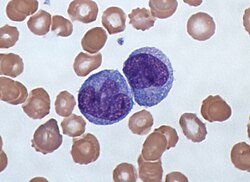Monocytes
| Monocyte | |
|---|---|

|
|
| Details | |
| Identifiers | |
| Latin | monocytus |
| Code | TH H2.00.04.1.02010 |
|
Anatomical terminology
[]
|
|
Monocytes are a type of white blood cell, or leukocyte. They are the largest type of leukocyte and can differentiate into macrophages and myeloid lineage dendritic cells. As a part of the vertebrate innate immune system monocytes also influence the process of adaptive immunity. There are at least three subclasses of monocytes in human blood based on their phenotypic receptors.
Monocytes are amoeboid in appearance, and have a granulated cytoplasm. Containing unilobar nuclei, these cells are one of the types of mononuclear leukocytes which shelter azurophil granules. The archetypal geometry of the monocyte nucleus is ellipsoidal; metaphorically bean-shaped or kidney-shaped, although the most significant distinction is that the nuclear envelope should not be hyperbolically furcated into lobes. Contrast to this classification occurs in polymorphonuclear leukocytes. Monocytes compose 2% to 10% of all leukocytes in the human body and serve multiple roles in immune function. Such roles include: replenishing resident macrophages under normal conditions; migration within approximately 8–12 hours in response to inflammation signals from sites of infection in the tissues; and differentiation into macrophages or dendritic cells to effect an immune response. In an adult human, half of the monocytes are stored in the spleen. Monocytes are generally identified in stained smears by the large kidney shaped or notched nucleus. These change into macrophages after entering into appropriate tissue spaces, and can transform into foam cells in endothelium .
...
Wikipedia
